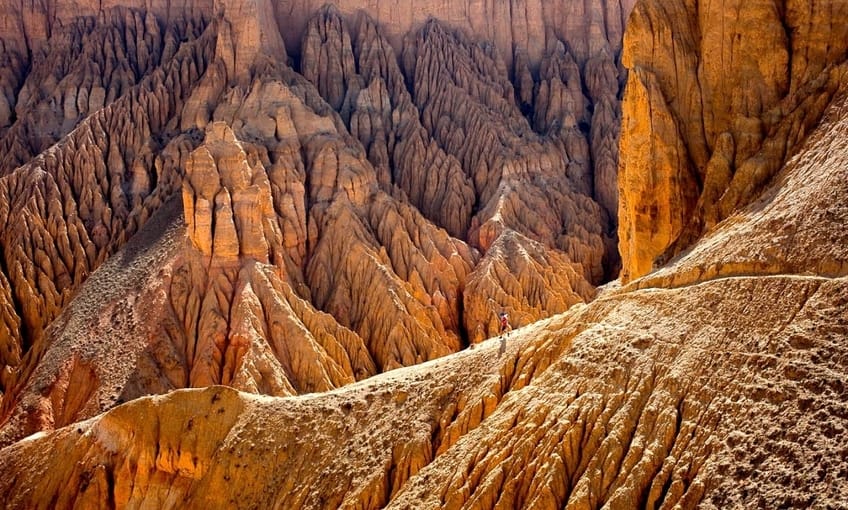
Introduction to Upper Mustang’s Restricted Status
Upper Mustang, often called Nepal’s “Last Forbidden Kingdom,” is one of the few places in the world where travel is still tightly controlled. Nestled in the remote Himalayas, this region shares a sensitive border with Tibet (China), which plays a major role in why access is limited. Unlike other popular trekking destinations in Nepal, Upper Mustang requires special permits, and travelers must go through registered agencies. These rules aren’t just about bureaucracy—they help protect the area’s unique Tibetan Buddhist culture, fragile desert-like environment, and historical treasures from being overwhelmed by mass tourism.
Beyond its stunning landscapes, Upper Mustang is a living museum of ancient traditions. The local Loba people have preserved their way of life for centuries, with monasteries, cave dwellings, and medieval villages remaining almost untouched by modern influences. The restrictions ensure that tourism doesn’t disrupt this delicate balance. While the rules might seem strict, they actually make the journey more special—only a small number of visitors get to experience this hidden gem each year, keeping it authentic and unspoiled.
Why Upper Mustang is a Restricted Zone
Geopolitical Sensitivity: Why Upper Mustang is a Restricted Zone
Upper Mustang’s status as a restricted area is largely due to its sensitive location along Nepal’s border with Tibet (China). This region has long been a crossroads for trade, migration, and political influence, making it strategically important. Here’s why the Nepalese government tightly controls access:
1. Proximity to the Tibet-China Border
Upper Mustang shares a direct border with China’s Tibet Autonomous Region, an area with a history of political tensions. Nepal, as a neutral neighbor, must carefully manage cross-border movements to avoid diplomatic issues. Unregulated travel could lead to illegal crossings, smuggling, or espionage concerns, which is why permits and guided treks are mandatory.
2. Historical and Strategic Importance
For centuries, Upper Mustang was an independent kingdom with strong ties to Tibet. Even after being annexed by Nepal in the 18th century, it remained culturally and economically linked to Tibet. During the 1950s Chinese annexation of Tibet, many refugees fled through Upper Mustang, and the region briefly hosted CIA-backed Tibetan guerrilla fighters. This history makes it a politically sensitive zone that Nepal monitors closely.
3. Preventing Unauthorized Activities
The remote, sparsely populated terrain could be exploited for illegal activities, such as unauthorized border crossings or smuggling. By requiring permits and registered guides, Nepal ensures that all visitors are accounted for and that no one enters restricted border zones without permission.
4. Diplomatic Relations with China
Nepal maintains a delicate balancing act between its two giant neighbors, India and China. Strict control over Upper Mustang helps Nepal demonstrate its commitment to border security, fostering trust with China. Allowing unrestricted tourism could risk accusations of negligence, especially given Tibet’s ongoing political sensitivities.
5. Controlled Cultural Exchange
While tourism is encouraged, Nepal wants to prevent excessive foreign influence in a region that has preserved Tibetan Buddhist traditions for centuries. Unregulated visitors could introduce unwanted cultural shifts, which is why interactions are carefully managed through guided tours.
Upper Mustang’s geopolitical sensitivity makes its restricted status necessary. By controlling access, Nepal protects its borders, maintains diplomatic stability, and preserves the region’s unique cultural identity. For travelers, this means that visiting Upper Mustang is not just an adventure—it’s a carefully regulated privilege that ensures the region remains untouched by outside pressures.
Cultural and Historical Preservation
Upper Mustang is one of the last places where traditional Tibetan culture thrives outside of Tibet itself. The walled city of Lo Manthang, ancient sky caves, and centuries-old monasteries like Jampa and Thubchen Gompa are irreplaceable treasures. If too many tourists visited without regulation, these sites could suffer from wear and tear, vandalism, or even theft of artifacts. The permit system helps control the number of visitors, ensuring that the region’s heritage remains intact for future generations.
The Loba people, who follow Tibetan Buddhism, have maintained their customs, language, and festivals for hundreds of years. Unlike in more tourist-heavy areas, their way of life hasn’t been commercialized. The restrictions prevent the kind of rapid cultural change that has happened in other parts of Nepal, where traditions sometimes become performances for tourists rather than daily life. By limiting access, Upper Mustang’s culture stays genuine, and visitors get a rare glimpse into a truly preserved Himalayan society.
Environmental Considerations
Upper Mustang’s high-altitude desert ecosystem is incredibly fragile. With very little rainfall, sparse vegetation, and limited water sources, the land can’t handle large numbers of people. Uncontrolled tourism could lead to problems like litter, soil erosion, and pressure on local resources. The restrictions help minimize human impact, keeping the landscapes pristine—whether it’s the wind-carved cliffs of Drakmar or the sacred Muktinath springs.
The Nepalese government also uses permit fees to fund conservation efforts. Part of the $500 RAP cost goes toward environmental projects, like maintaining trails and protecting wildlife. Since the region is so remote, waste management and infrastructure are limited, meaning fewer visitors help reduce pollution. Travelers who visit Upper Mustang under these rules play a part in preserving its natural beauty rather than harming it.
Permit System and Access Rules
To enter Upper Mustang, foreign travelers must obtain a Restricted Area Permit (RAP), which costs $50 for 10 days, with an additional $5 per day if staying longer. They also need an Annapurna Conservation Area Permit (ACAP) for about $20. These permits are only issued through registered trekking agencies, and solo travel isn’t allowed—you must be part of a group of at least two trekkers with a guide. These rules ensure that visitors are accounted for and that tourism benefits local guides and businesses.
The permit system isn’t just about controlling numbers—it also enhances safety. Upper Mustang’s rugged terrain, high altitude, and limited facilities mean that traveling with an experienced guide is essential. The rules help prevent accidents and ensure that if something goes wrong, help is available. While the cost might seem high, it contributes to the region’s sustainability and helps maintain the unique experience of visiting a place few visit.
Restricted Status And Its Impact on Tourism and Local Communities
Impact on Tourism and Local Communities in Upper Mustang
The restricted access policy in Upper Mustang has created a unique tourism model that balances economic benefits with cultural and environmental protection. Unlike Nepal’s more popular trekking routes, Upper Mustang offers an exclusive, crowd-free experience, attracting travelers seeking authenticity rather than mass tourism. This controlled approach has several key impacts on both visitors and local communities.
1. Sustainable Tourism Development
Because only a limited number of permits are issued each year, Upper Mustang avoids the over-tourism problems seen in places like Everest Base Camp or Annapurna. The high permit fee ($500 for 10 days) ensures that tourism remains low-impact while generating significant revenue. This money is reinvested into local infrastructure, such as trail maintenance, schools, and health clinics, helping improve living standards without disrupting traditional lifestyles.
2. Preservation of Local Culture
The Loba people, who follow Tibetan Buddhist traditions, have maintained their way of life for centuries. Unlike in heavily touristed areas, where culture can become commercialized, Upper Mustang’s restrictions prevent excessive outside influence. Festivals like the Tiji Festival remain genuine spiritual events rather than tourist spectacles. Additionally, the requirement for guided treks ensures that visitors engage respectfully with local customs, reducing the risk of cultural erosion.
3. Economic Benefits for Locals
While tourism is limited, it provides crucial income for the Loba community. Teahouse owners, guides, horse handlers, and artisans all benefit from the controlled flow of visitors. Since independent trekking is not allowed, local trekking agencies and guides receive steady work, ensuring that profits stay within the region. The permit system also discourages budget backpackers, meaning those who visit tend to spend more, further supporting the local economy.
4. Environmental Protection
Upper Mustang’s arid, high-altitude desert ecosystem is extremely fragile. The restriction on visitor numbers minimizes pollution, waste, and strain on scarce water resources. Unlike in Nepal’s busier trails, where litter and erosion are growing problems, Upper Mustang’s pristine landscapes remain largely untouched. The permit fees also fund conservation efforts, helping maintain trails and protect wildlife.
5. Exclusivity and High-Value Tourism
The restrictions create a sense of prestige around visiting Upper Mustang, appealing to travelers looking for a rare and meaningful experience. Instead of crowded lodges and overused trails, visitors enjoy peaceful hikes, personal interactions with locals, and a deep connection to the region’s history. This exclusivity makes Upper Mustang a bucket-list destination for serious adventurers and culture enthusiasts.
6. Challenges and Future Considerations
While the current system works well, there are concerns about accessibility. The high permit cost may deter some travelers, and reliance on a single tourism model could be risky if visitor numbers fluctuate. Some locals also hope for more infrastructure development, such as better roads and healthcare, without sacrificing cultural integrity. Finding the right balance between growth and preservation will be key to Upper Mustang’s future.
Upper Mustang’s restricted tourism model has successfully protected its culture, environment, and unique identity while providing locals with economic benefits. Limiting visitor numbers and enforcing strict regulations make the region one of the last truly untouched Himalayan destinations. For travelers, this means an unforgettable journey into a living medieval kingdom—one that few will ever have the privilege to see.
Conclusion
Upper Mustang’s restricted status exists for good reasons—geopolitical sensitivity, cultural preservation, and environmental protection. While the rules might add some extra steps for travelers, they ensure that this extraordinary region remains unspoiled. The permit system keeps visitor numbers low, protects ancient traditions, and helps maintain the delicate desert ecosystem.
For those lucky enough to visit, the restrictions enhance the experience. Instead of fighting crowds, you’ll walk through silent canyons, explore untouched monasteries, and meet locals who still live as their ancestors did. By respecting these regulations, travelers play a part in keeping Upper Mustang’s magic alive. It’s not just a trek; it’s a privilege to witness a hidden world that has stayed timeless against all odds.



